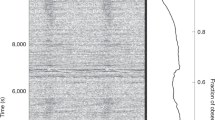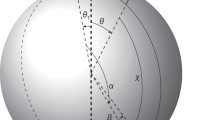Abstract
Anomalous X-ray pulsars1 (AXPs) differ from ordinary radio pulsars in that their X-ray luminosity is orders of magnitude greater than their rate of rotational energy loss, and so they require an additional energy source. One possibility is that AXPs are highly magnetized neuron stars2—or ‘magnetars’—having surface magnetic fields greater than 1014 G. This would make them similar to the soft γ-ray repeaters (SGRs)3, but alternative models that do not require extreme magnetic fields also exist. An optical counterpart to the AXP 4U0142+61 was recently discovered4, consistent with emission from a magnetar, but also from a magnetized hot white dwarf5, or an accreting isolated6 neutron star7. Here we report the detection of optical pulsations from 4U0142+61. The pulsed fraction of optical light (27 per cent) is five to ten times greater than that of soft X-rays, from which we conclude that 4U0142+61 is a magnetar. Although this establishes a direct relationship between AXPs and the soft γ-ray repeaters, the evolutionary connection between AXPs, SGRs and radio pulsars remains controversial.
This is a preview of subscription content, access via your institution
Access options
Subscribe to this journal
Receive 51 print issues and online access
$199.00 per year
only $3.90 per issue
Buy this article
- Purchase on Springer Link
- Instant access to full article PDF
Prices may be subject to local taxes which are calculated during checkout



Similar content being viewed by others
References
Mereghetti, S. in The Neutron Star–Black Hole Connection (eds Kouveliotou, C., Ventura, J. & van den Heuvel, E. P. J.) 351–368 (Kluwer Academic, Dordrecht, 2001); also preprint astro-ph/9911252 at 〈http://xxx.lanl.gov/〉 (1999)
Duncan, R. C. & Thompson, C. Formation of very strongly magnetized neutron stars: Implications for gamma-ray bursts. Astrophys. J. 392, L9–L13 (1992)
Kouveliotou, C. et al. An X-ray pulsar with a superstrong magnetic field in the soft γ-ray repeater SGR 1806-20. Nature 393, 235–237 (1998)
Hulleman, F., van Kerkwijk, M. H. & Kulkarni, S. R. An optical counterpart to the anomalous X-ray pulsar 4U0142+61. Nature 408, 689–692 (2000)
Paczyński, B. X-ray pulsar 1E 2259 + 586: A merged white dwarf with a 7 second rotation period? Astrophys. J. 365, L9–L12 (1990)
Wilson, C. A., Dieters, S., Finger, M. H., Scott, D. M. & van Paradijis, J. Rossi X-ray Timing Explorer observations of the anomalous pulsar 4U 0142 + 61. Astrophys. J. 513, 464–470 (1999)
Marsden, D., Lingenfelter, R. E., Rothschild, R. E. & Higdon, J. C. Nature versus nurture: the origin of soft gamma-ray repeaters and anomalous X-ray pulsars. Astrophys. J. 550, 397–409 (2001)
White, N. E., Angelini, L., Ebisawa, K., Tanaka, Y. & Ghosh, P. The spectrum of the 8.7 s X-ray pulsar 4U 0142 + 61. Astrophys. J. 463, L83–L86 (1996)
Romani, R. W., Miller, A. J., Cabrera, B., Nam, S. W. & Martinis, J. M. Phase-resolved Crab studies with a cryogenic transition-edge sensor spectrophotometer. Astrophys. J. 563, 221–228 (2001)
Tennant, A. F. et al. Discovery of X-ray emission from the Crab pulsar at pulse minimum. Astrophys. J. 554, L173–L176 (2001)
Helfand, D. J., Gotthelf, E. V. & Halpern, J. P. Vela pulsar and its synchrotron nebula. Astrophys. J. 556, 380–391 (2001)
Manchester, R. N., Wallace, P. T., Peterson, B. A. & Elliott, K. H. The optical pulse profile of the Vela pulsar. Mon. Not. R. Astron. Soc. 190, 9P–11P (1980)
Gotthelf, E. V. & Wang, Q. D. A spatially resolved plerionic X-ray nebula around PSR B0540-69. Astrophys. J. 532, L117–L120 (2000)
Boyd, P. T. et al. High-Speed Photometer observations of the LMC pulsar B0540-69. Astrophys. J. 448, 365–368 (1995)
Chester, T. J. Continuum optical pulsation from the companions of binary X-ray pulsars. Astrophys. J. 227, 569–578 (1979)
Pedersen, H. et al. Simultaneous optical and X-ray bursts from 4U/MXB 1636-53. Astrophys. J. 263, 325–339 (1982)
Pechenick, K. R., Ftaclas, C. & Cohen, J. M. Hot spots on neutron stars: The near-field gravitational lens. Astrophys. J. 274, 846–857 (1983)
Perna, R. & Hernquist, L. Disks irradiated by beamed radiation from compact objects. Astrophys. J. 544, L57–L60 (2000)
Hulleman, F., van Kerkwijk, M. H., Verbunt, F. W. M. & Kulkarni, S. R. A deep search for the optical counterpart to the anomalous X-ray pulsar 1E 2259 + 58.6. Astron. Astrophys. 358, 605–611 (2000)
Barstow, M. A. et al. RE J0317-853: the hottest known highly magnetic DA white dwarf. Mon. Not. R. Astron. Soc. 277, 971–985 (1995)
Ferrario, L., Vennes, S., Wickramasinghe, D. T., Bailey, J. A. & Christian, D. J. EUVE J0317-855: a rapidly rotating, high-field magnetic white dwarf. Mon. Not. R. Astron. Soc. 292, 205–217 (1997)
Piirola, V. & Reiz, A. The highly magnetic (B∼500 MG) white dwarf PG 1031 + 234: Discovery of wavelength dependent polarization and intensity variations. Astron. Astrophys. 259, 143–148 (1992)
Achilleos, N., Wickramasinghe, D. T., Liebert, J., Saffer, R. A. & Grauer, A. D. Exploring the peculiar magnetic field of Feige 7. Astrophys. J. 396, 273–288 (1992)
Heise, J., van Teeseling, A. & Kahabka, P. The spectra and luminosity of super-soft X-ray sources. Astron. Astrophys. 288, L45–L48 (1994)
Rauch, T. in Supersoft X-ray Sources (ed. Greiner, J.) 139–142 (Springer, Berlin, 1996)
Baring, M. G. & Harding, A. K. Photon splitting and pair creation in highly magnetized pulsars. Astrophys. J. 547, 929–948 (2001)
Shaviv, N. J., Heyl, J. S. & Lithwick, Y. Magnetic lensing near ultramagnetized neutron stars. Mon. Not. R. Astron. Soc. 306, 333–347 (1999)
Reid, C. A. et al. Unidentified galactic X-ray sources positioned with the HEAO-1 scanning modulation collimator. Astron. J. 85, 1062–1070 (1980)
Coe, M. J. & Pightling, S. L. Deep infrared and optical studies of the fields of three proposed TŻO remnants. Mon. Not. R. Astron. Soc. 299, 223–228 (1998)
Gavriil, F. P. & Kaspi, V. M. Long-term Rossi X-ray Timing Explorer monitoring of anomalous X-ray pulsars. Astrophys. J. 567, 1067–1076 (2002)
Acknowledgements
We thank S. Kaye, the Palomar Observatory staff, D. Kaplan, S. Kulkarni and R. Rutledge for assistance. This work was supported by grants from the National Science Foundation and the California Institute of Technology.
Author information
Authors and Affiliations
Corresponding author
Ethics declarations
Competing interests
The authors declare that they have no competing financial interests.
Rights and permissions
About this article
Cite this article
Kern, B., Martin, C. Optical pulsations from the anomalous X-ray pulsar 4U0142+61. Nature 417, 527–529 (2002). https://doi.org/10.1038/417527a
Received:
Accepted:
Issue Date:
DOI: https://doi.org/10.1038/417527a
This article is cited by
-
Magnetars: Properties, Origin and Evolution
Space Science Reviews (2015)
-
Pulsars and Magnetars
Brazilian Journal of Physics (2013)
-
How fast can you blink?
Nature (2008)
-
The strongest cosmic magnets: soft gamma-ray repeaters and anomalous X-ray pulsars
The Astronomy and Astrophysics Review (2008)
-
Non-LTE modeling of supernova-fallback disks
Astrophysics and Space Science (2007)
Comments
By submitting a comment you agree to abide by our Terms and Community Guidelines. If you find something abusive or that does not comply with our terms or guidelines please flag it as inappropriate.



